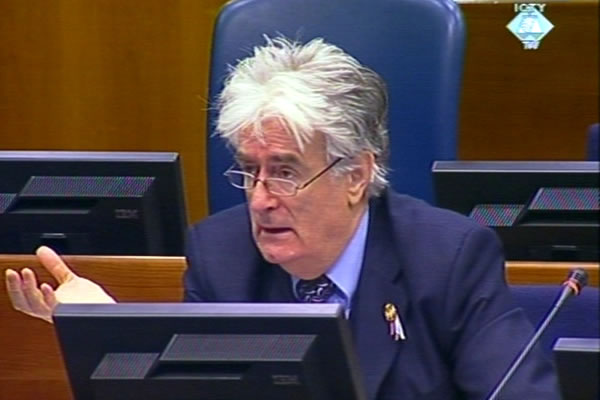Home
SARAJEVO'S ‘PLACES OF HORROR’
At the trial of Radovan Karadzic, protected witness KDZ-166 described ‘places of horror’ where Sarajevo civilians were killed in explosions of shells and modified air bombs
 Radovan Karadzic in the courtroom
Radovan Karadzic in the courtroom As a forensic crime technician in the Sarajevo Security Services Center, protected witness KDZ-166 was involved in several investigations of artillery and sniper incidents in the city. The witness took photos and made sketches of crime scenes, and collected shell fragments and other physical evidence.
In his examination-in chief at the trial of Radovan Karadzic, the witness talked about six artillery incidents: the shell that hit people queuing for humanitarian aid in Dobrinja on 4 February 1994, the impact of a modified air bomb at the Medjunarodnog prijateljstva Square and the incidents in the Majdanska street on 24 May 1995, in the Safeta Zajke Street on 24 May and in Hrasnica on 7 April 1995.
As the witness recounted, in most cases, the investigation team went to conduct crime scene investigations as soon as an incident was reported. This was not done only in exceptional circumstances, when there was intense shelling which put the lives of the investigators at risk. At crime scenes, they usually found pools of blood, scattered body parts and bones, pieces of clothes or shoes... ‘You could see that you have come to a place of horror’, the witness said.
In the cross-examination Karadzic suggested that the authorities in Sarajevo ‘changed’ the incident scenes. To corroborate his claim, he said that the photos the witness had taken did not show any victims; the chalk outlines, typically done in peacetime to show the positions of bodies, are not seen on the photographs.
As the witness explained, the reason was very simple: it was ‘a matter of life and death’. After the explosions, the survivors ‘automatically’ tried to help the injured and get them to hospital as soon as possible to receive treatment. ‘You are a doctor, you should know that’, the witness told Karadzic’.
Replying to the accused, the witness confirmed that in investigations the distance between the incident site and the locations from which rounds might have been fired was not determined. He did reject the suggestion that the BH Army fired at its own citizens. Karadzic then asked the witness how the investigation team members were able to conclude that the Serbs had fired the rounds, based only on the direction from which they were fired. The witness replied, ‘you’d have to be abnormal to fire at yourself’.
The trial continues tomorrow morning with the evidence of the former UNPROFOR chief of staff in Sarajevo, Dutch general Adrianus Van Baal.
